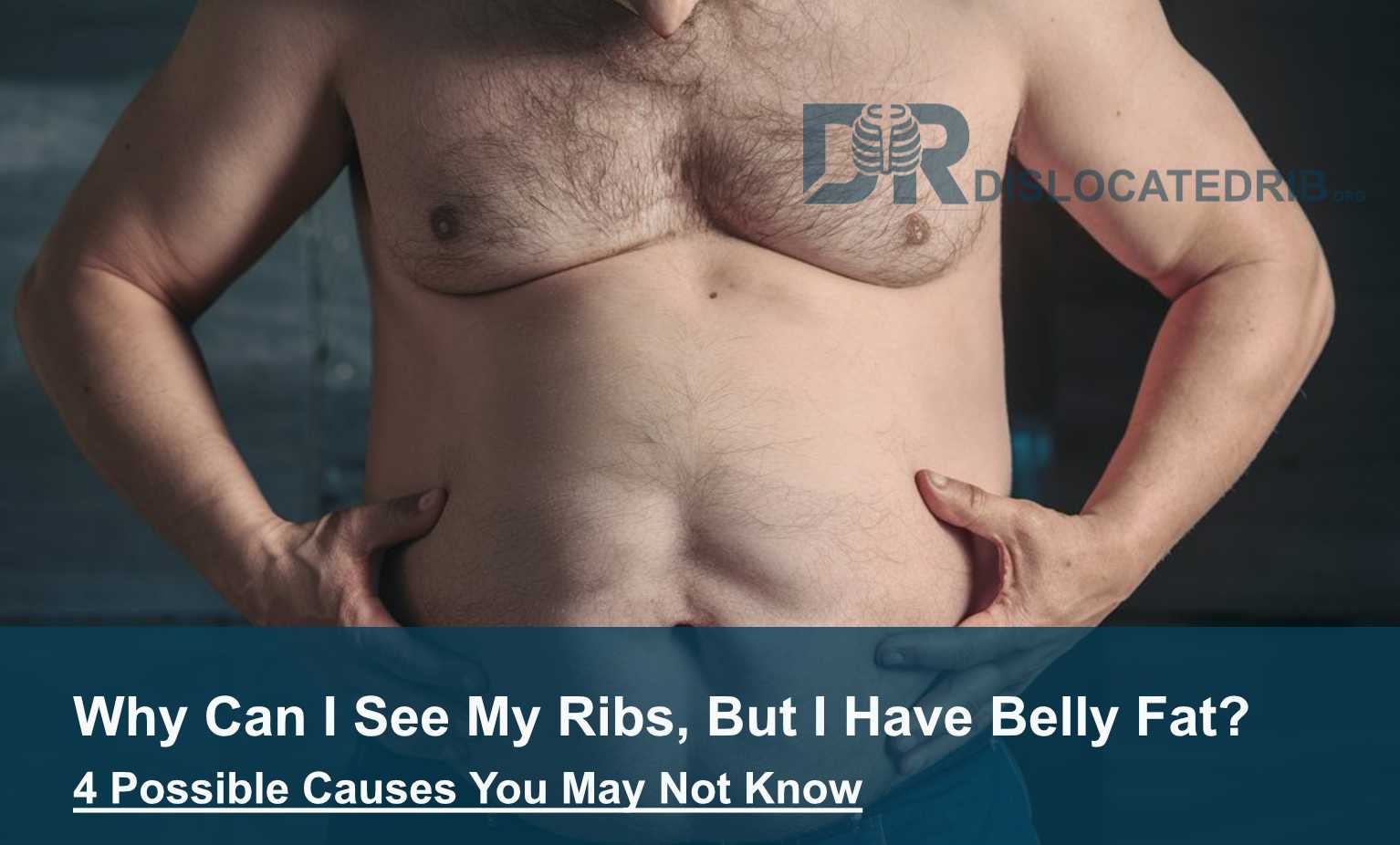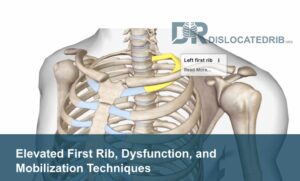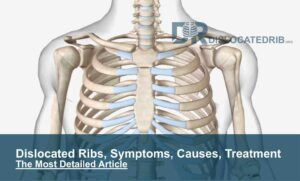Seeing Your Ribs But Still Having Belly Fat: Unveiling the Mystery
It’s not uncommon to see a seemingly contradictory image in the mirror: visible ribs protruding despite having belly fat. This phenomenon can be caused by a combination of factors related to body composition, genetics, and posture. Let’s delve deeper into the possible reasons behind this and explore solutions to achieve a more balanced physique.
Reasons Why You Can See Your Ribs But Have Belly Fat:
Here are the possible answers to the question, “Why can I see my ribs, but I have belly fat?”
1. Body Composition and Visible Ribs with Belly Fat
The image of visible ribs peeking out from under a layer of belly fat can be a source of confusion. To shed more light on it, we will need to look at the science of body composition and how it plays a role in this seemingly contradictory phenomenon.
Body Composition 101:
Your body composition is essentially the ratio of muscle mass (lean mass) to fat mass. Imagine two people who weigh the same on the scale; their bodies can look vastly different depending on their body composition. Here’s why muscle mass is key:
- Muscle Density: Muscle tissue is much denser than fat tissue. This means a pound of muscle takes up less space in your body compared to a pound of fat. So, someone with a higher percentage of muscle mass will have a more compact and toned appearance, even if they have some body fat.
- Metabolic Powerhouse: Muscle is metabolically active, meaning it burns calories even at rest. This contributes to a higher basal metabolic rate (BMR), which means the number of calories your body burns simply to function. In simpler terms, someone with more muscle burns more calories throughout the day, even when not actively exercising.
Visible Ribs and Fat Distribution:
Now, let’s connect this to the case of visible ribs and belly fat. Here are some factors at play:
- Lower Muscle Mass: If you have a naturally lower muscle mass percentage, your ribs might be more prominent, even if you have some belly fat. The underlying muscle simply doesn’t take up as much space, allowing the ribcage to show through.
- Fat Distribution: Genetics play a major role in the way your body stores fat. Some individuals tend to be “apple-shaped,” meaning they store more fat in the abdominal area (visceral fat). This visceral fat accumulates around the organs and can contribute to a protruding belly even if the overall body fat percentage isn’t extremely high. Conversely, others might be “pear-shaped,” storing fat more in the hips and thighs (subcutaneous fat). In this case, someone with a higher overall body fat percentage might still have a less defined midsection due to the location of fat storage.
Beyond Muscle and Fat:
Body composition isn’t just about muscle and fat. Other additional factors that can influence how your body carries weight and potentially contribute to visible ribs with belly fat may include either one or more of the following:
- Bone Structure: People with naturally larger or wider ribcages might have ribs that are more prominent, even with a layer of belly fat.
- Water Weight: Fluctuations in water weight can also play a role. Dehydration can make ribs appear more pronounced, while proper hydration can lead to a slightly smoother appearance.
You May Also Like:
2. The Fat Distribution: Why You Can See Your Ribs But Have Belly Fat
Another unpopular reason why you may see your ribs when your have belly fat lies on where your body chooses to store its fat reserves. This distribution of fat plays a significant role in shaping your physique and can explain reason behind the contradiction why you see your ribs when you have belly fat.
Two Types of Fat Storage:
Did you know that our bodies store fats in different locations? This location can differ for each person depending on many factors.
Your body stores fat in two main locations:
- Visceral Fat: This type of fat, also known as abdominal fat, accumulates deep within the abdominal cavity, surrounding your organs like the liver, intestines, and kidneys. Visceral fat is considered the more dangerous location of fat storage than subcutaneous fat, as it’s linked to an increased susceptibility to heart disease, type 2 diabetes, and some cancers.
- Subcutaneous Fat: This fat resides just under the skin throughout your body, including your arms, legs, hips, buttocks, and abdomen. While not ideal aesthetically, subcutaneous fat is generally considered less harmful than visceral fat.
Genetics Dictates the Distribution:
Genetics plays a major role in determining where your body stores fat. Here’s how it impacts the visible ribs and belly fat scenario:
- Apple vs. Pear Shapes: Some individuals are genetically predisposed to be “apple-shaped.” Their bodies tend to store more visceral fat in the abdominal area. This can lead to a protruding belly even if their overall body fat percentage isn’t extremely high. In such cases, the visceral fat accumulation around the organs pushes outwards, making the abdomen appear larger despite potentially having relatively low levels of subcutaneous fat in the abdominal wall itself. This can leave the ribcage more exposed.
- Pear-Shaped Fat Distribution: Conversely, “pear-shaped” individuals tend to store more fat subcutaneously, primarily in the hips and thighs. They might have a higher overall body fat percentage but might still have a less defined midsection due to the location of fat storage. In this case, even with some belly fat, the ribs might not be visible because the subcutaneous fat in the abdominal wall can mask the underlying ribcage.
Understanding the Implications:
The location of fat storage has health implications beyond aesthetics. Visceral fat, concentrated in the apple-shaped body type, is linked to a higher risk of chronic diseases. Therefore, if you have visible ribs and a protruding belly, it’s important to consult with a doctor to assess your body composition and overall health.
3. The Genetic Influence on Fat Distribution and Storage
The human body is a marvel of intricate biological processes, and fat storage is no exception. While diet and exercise undoubtedly play a role, genetics, as mentioned earlier, hold a significant trump card in how your body chooses to store and distribute fat. This pre-determined “blueprint” can explain why some individuals seem to effortlessly maintain a more toned appearance while others struggle with stubborn fat deposits in specific areas, like the abdomen, despite having visible ribs.
The Symphony of Genes:
Our DNA acts like a complex musical score, with each gene playing a specific instrument in the symphony of life. Some genes directly influence how our bodies store and distribute fat. These genes can code for proteins involved in:
- Fat cell development (adipogenesis): Certain genes regulate the creation and number of fat cells (adipocytes) throughout the body.
- Fat storage and breakdown: Genes control how readily our bodies store excess calories as fat and how efficiently they break down existing fat stores for energy.
- Fat distribution patterns: Specific genes dictate where fat is more likely to accumulate, influencing the “apple” or “pear” body shape tendencies.
The Hereditary Dance:
These fat-regulating genes are passed down from our parents. Here’s how this inheritance can impact fat distribution:
- Predisposition to Visceral Fat: If you inherit genes that promote visceral fat storage, you might be more prone to having a protruding belly, even if your overall body fat percentage is moderate. This can lead to the seemingly contradictory sight of visible ribs due to the way visceral fat accumulates around organs, pushing outwards.
- Genetic Predisposition to Subcutaneous Fat: Inheriting genes that favor subcutaneous fat storage can result in a higher overall body fat percentage but with a less defined midsection. The subcutaneous fat in the abdominal wall can mask the underlying ribcage, even with some belly fat.
It’s Not Just About Fat:
While genes significantly influence fat distribution, they don’t operate in isolation. Here are some additional factors that interact with genetics:
- Sex Hormones: Estrogen and testosterone play a role in fat storage patterns. Women tend to store more fat in the hips and thighs due to the influence of estrogen, while men might be more prone to abdominal fat accumulation due to testosterone.
- Diet and Exercise: Genetics might set the stage, but you can still influence the amount of fat your body stores. Maintaining a healthy diet and engaging in regular exercise can help manage overall body fat percentage and potentially influence fat distribution to some extent.
4. Posture: The Unsung Hero of a Balanced Physique
While genetics and body composition play a significant role in how your body carries weight, posture often gets overlooked as a factor influencing the visibility of your ribs and the overall appearance of your midsection. Here’s how good posture can work wonders and why slouching might be contributing to the “visible ribs with belly fat” dilemma.
The Slouching Slump:
Poor posture, particularly slouching, can have a significant impact on how your body is positioned and how your weight is distributed. Here’s how slouching affects your physique:
- Pushed-Out Ribcage: When you slouch, your shoulders round forward, and your upper back hunches. This pushes your ribcage outwards, making it appear more prominent. This can be especially noticeable in individuals with a naturally lower muscle mass, as there’s less underlying muscle tone to hold the ribs in place.
- Weak Core: Slouching often weakens your core muscles, the group of muscles that support your spine and pelvis. A weak core can’t effectively hold your torso upright, further contributing to a protruding ribcage and a less defined midsection.
- Increased Belly Fat Appearance: Slouching can also push your abdominal contents downwards, potentially making your belly appear larger, even if your overall body fat percentage isn’t high.
Standing Tall with Good Posture:
Conversely, good posture has a multitude of benefits, including:
- Tucked-In Ribs: Maintaining proper posture with your shoulders back and down, core engaged, and spine straight naturally pulls your ribcage inwards. This can create a more toned and streamlined appearance, even if you have some belly fat.
- Strong Core: Good posture relies on a strong core, which not only improves your overall stability but also helps hold your torso upright, reducing the appearance of a protruding ribcage and a protruding belly.
- Confidence Boost: Good posture can make you feel more confident and empowered. It projects an air of self-assurance and can even make you appear taller and slimmer.
Beyond Aesthetics: The Health Benefits of Good Posture
The benefits of good posture go far beyond aesthetics. Here are some additional reasons to prioritize good posture:
- Reduced Back Pain: Poor posture can strain your back muscles, thereby leading to pain and discomfort. Good posture helps distribute your overall body weight evenly, reducing strain on your back.
- Improved Breathing: Slouching can restrict your chest cavity, making it harder to take deep breaths. Good posture allows for optimal lung expansion and improved breathing.
- Enhanced Mood: Studies have shown that good posture can be linked to a more positive mood and increased energy levels.
Tips for Maintaining Good Posture:
- Mind Your Body: Throughout the day, consciously check your posture and correct any slouching tendencies. Imagine a string pulling you up from the crown of your head.
- Strengthen Your Core: Engage in core-strengthening exercises like planks, bridges, and crunches to build a strong core that can support good posture.
- Ergonomics Matter: Pay attention to your ergonomics at work and home. Use chairs with good back support and keep your computer screen at eye level to avoid slouching.
- Stretch It Out Tight hamstrings and chest muscles can contribute to slouching. Regularly stretch these muscle groups to improve flexibility and maintain proper posture.
Remember, good posture is a powerful tool that can influence the appearance of your ribs and belly fat. By consciously correcting your posture and incorporating core strengthening exercises into your routine, you can achieve a more toned and balanced physique while reaping the numerous health benefits that come with standing tall.
Additional Symptoms to Consider:
While the primary concern might be the visible ribs and belly fat, other symptoms can sometimes be present:
- Lower back pain: Weak core muscles and poor posture can contribute to lower back pain.
- Bloating: Gas buildup or digestive issues might cause your abdomen to appear larger.
- Fatigue: Low muscle mass or underlying health conditions could lead to fatigue.
Solutions to Achieve a More Balanced Physique:
- Body Composition Improvement: Focus on building muscle mass through strength training exercises. Muscle burns more calories at rest, helping you lose fat overall and achieve a more toned look.
- Targeted Fat Loss: Unfortunately, spot reduction (losing fat in specific areas) isn’t entirely possible. However, a combination of healthy eating and full-body exercises can help reduce overall body fat percentage, leading to a decrease in belly fat.
- Healthy Eating Habits: Prioritize whole, unprocessed foods like fruits, vegetables, and lean proteins. Limit sugary drinks and unhealthy fats. Maintaining a calorie deficit is crucial for weight loss.
- Improve Your Posture: Practice good posture by keeping your shoulders back and down, core engaged, and spine straight. Strengthening core muscles can also support better posture.
- Consult a Doctor: If you have concerns about your body composition, other symptoms, or difficulty managing your weight, consult a healthcare professional. They can help you develop a personalized plan to address your specific needs.
Understanding all these factors that influence fat distribution should put your mind at ease about why you see your ribs in the presence of your belly fat, and it should give you more knowledge on how you can take control of your health. While you can’t change things like your genetic blueprint, you can focus on modifiable factors like diet and exercise. Talk to your personal doctor or a registered dietitian for assistance in creating a personalized plan to manage your weight and body composition, considering your genetic predispositions.
Remember: It’s important to focus on overall health and well-being rather than just achieving a specific aesthetic. Aim for sustainable weight management practices and celebrate progress along the journey.




